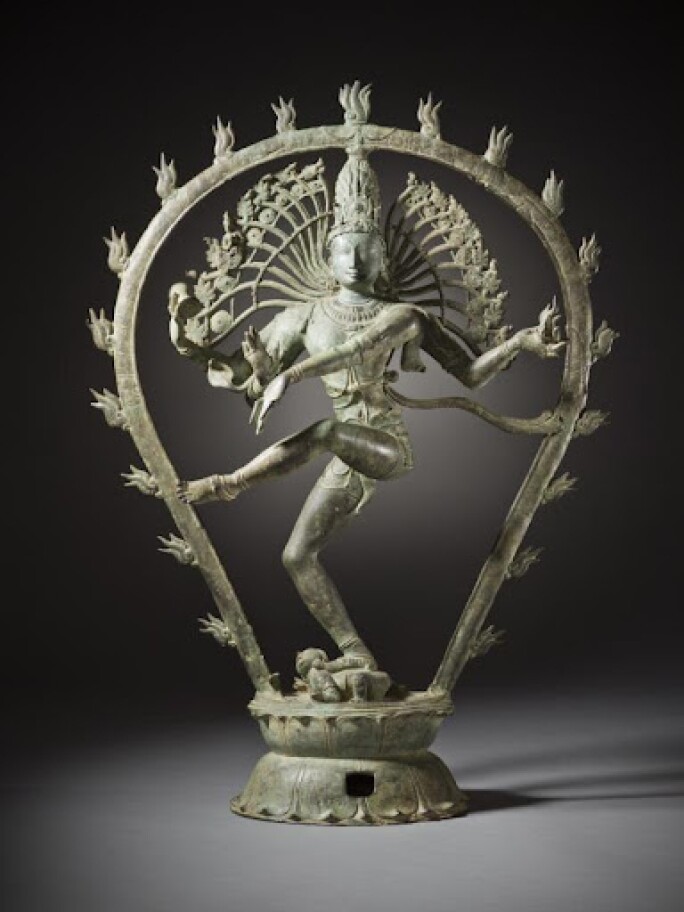“This is one of Manship’s finest creations, perfectly conceived in form, and of the most elegant surface finish. The repeated rhythmic patterns in the figures of the girl and the two animals give an almost musical feeling to the work.”
When Paul Manship exhibited the life size version of Dancer and Gazelles at the National Academy of Design in 1917, it received the illustrious Helen Foster Barnett Prize for the best work by a sculptor under the age thirty five (Harry Rand, Paul Manship, Washington, D.C., 1989, p. 47). Following the outpouring of success for the heroic edition, Manship issued a reduced cast at an edition size of just twelve bronzes. The Wolf Family’s Dancer and Gazelles hails from this reduction, which scholars have called a “superior work” to the original life size version (ibid).

Heralded for the harmony shared between the female figure and her two animal companions, the dancer at center appears to communicate with each deer individually. This light-hearted approach is a hallmark of Manship’s sculptural practice. Her hand gestures—one arm outstretched and the other raised—provide unique guidance in response to that specific deer’s body language. The frontal quality of the composition paired with the variation in hand gestures pervades the sculptural trio with a sense of balance. Many of Manship’s sculptures engage with animated narratives shared between humans and animals, and the present work is one of his most successful iterations in doing so.
Manship’s affinity for Greek archaism is well-documented, and he frequently expressed his appreciation for ancient sculptural techniques. “I am at present quite crazy about the Early Greek Art and expect to draw everything that I can lay my eyes upon,” he wrote in advance of a trip to Greece in the spring of 1912 (Exh. Cat., Paul Manship: Changing Taste in America, 1985, p. 66). This influence is evident in the garments of the female dancer, whose drapery rests effortlessly on her hips and clings to her moving legs. Her contrapposto stance is also highly reminiscent of classical Greek art. In examining Manship’s body of work and reading his first-hand explanations, the liaison between his art and Greek archaism is undeniable. In Dancer and Gazelles, though, it is the impact of Indian art on the American sculptor’s style that is distinctive and commonly discussed.
“The inspiration that Manship derived from Indian art is particularly apparent in this work.”
Both the torsion of the female figure’s body and the intricacy of her hand gestures evoke Eastern art. In Hinduism and Buddhism, mudras are non-verbal symbolic gestures which appear frequently in Indian iconography. The hand signals deployed by the central dancer could very well descend from Manship’s study of mudras. Shiva as the Lord of the Dance, located in the Los Angeles County Museum of Art’s collection, demonstrates the commonality between Manship’s Dancer and Gazelles and Indian imagery. Both works incorporate an extremely frontal pose with dynamic arm movement, prompting a comparison between the Manship bronze and representations of the great Hindu God.

When Paul Sachs, art historian and then curator at the Fogg Art Museum at Harvard University purchased a cast of Dancer and Gazelles for his own personal collection, he wrote to Manship, “among living Americans there is no sculptor whose work interests me as much as yours does” (John Manship, Paul Manship, New York, 1989, p. 78). It is unsurprising that a form such as Dancer and Gazelles caught Sachs’ attention. The figures are graceful and refined, an element which is made possible by Manship’s impeccable technique. A great deal of the draw to Dancer and Gazelles is the sense of ease that the figures exude, and the harmonious relationship between the central figure and the adjacent deer. Through Manship’s infatuation with ancient Greek teachings and Eastern imagery alike, this complex and idyllic image is ultimately achieved. Of the twelve casts Manship authorized of Dancer and Gazelles, many reside in major institutions, among them The Metropolitan Museum of Art, Smithsonian American Art Museum, National Gallery of Art, Washington, D.C., and the Art Institute of Chicago. The presence of one of these bronzes in private hands, and now at auction, is quite rare.